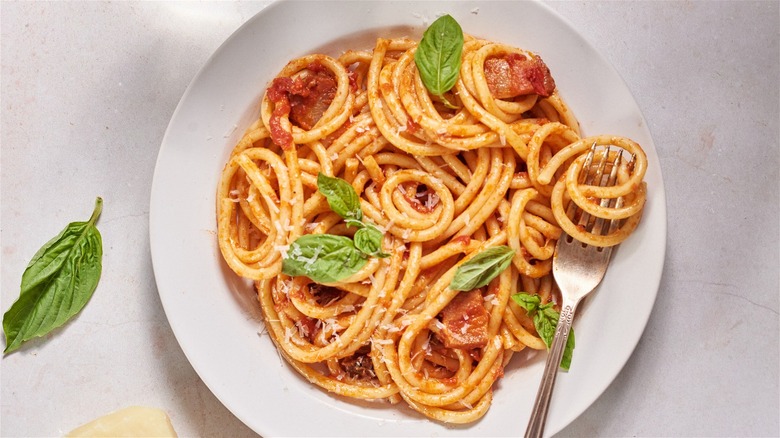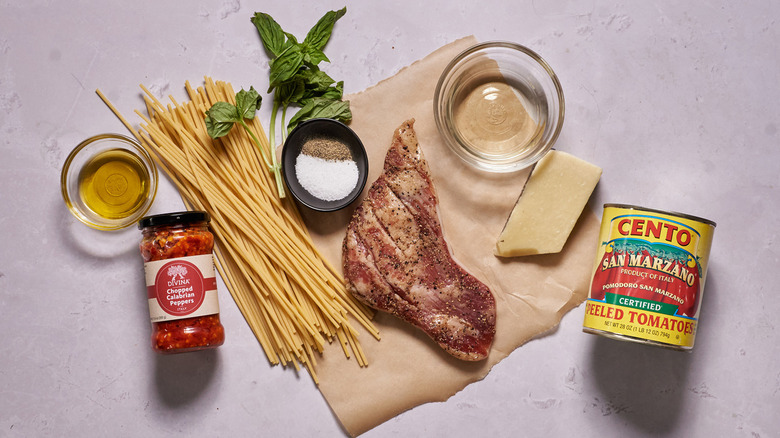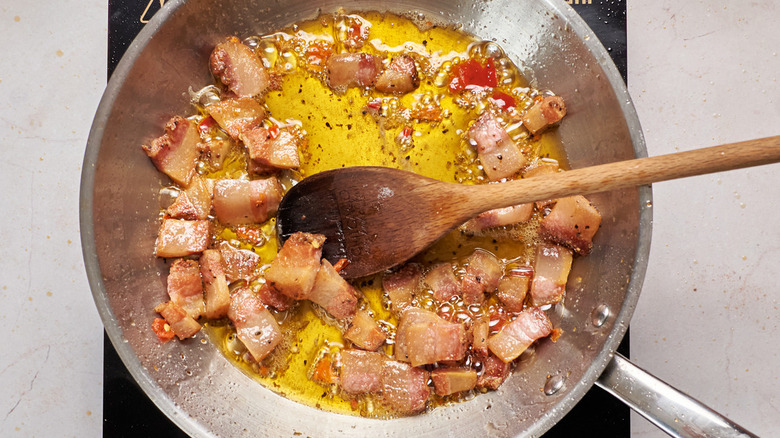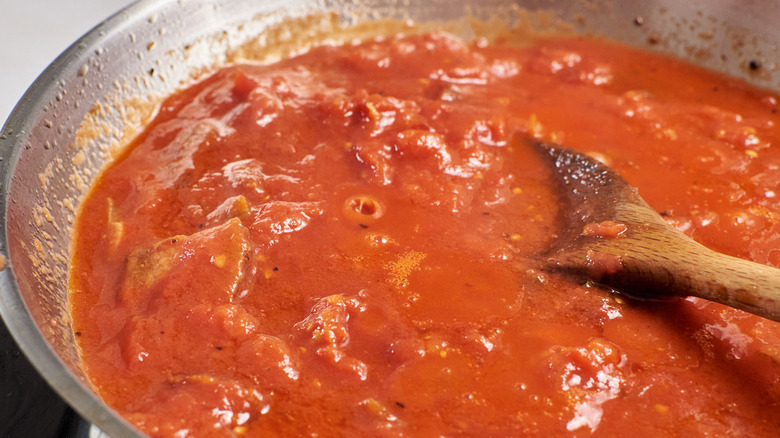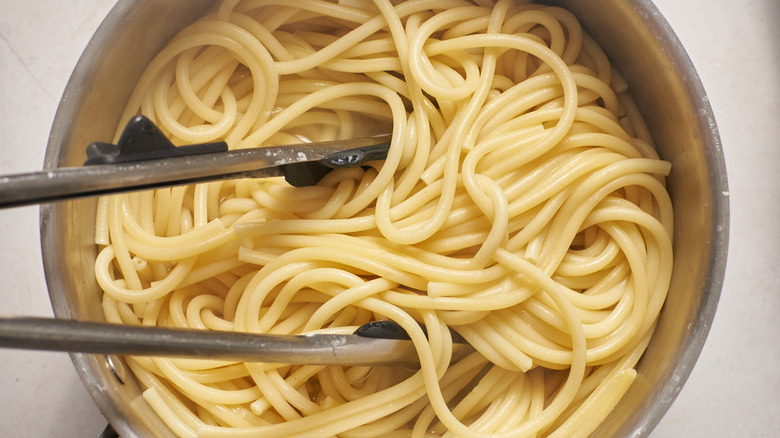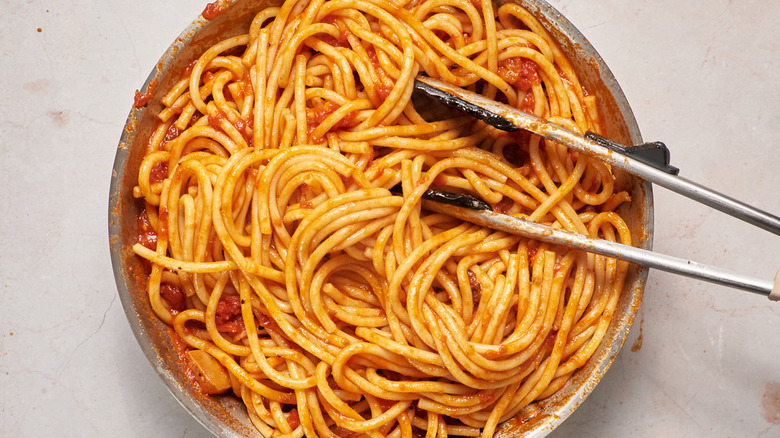Traditional Bucatini all'Amatriciana Recipe
Few things are better than a homemade red sauce, especially one as classic as Amatriciana. If you haven't heard of it, Amatriciana is a Roman tomato sauce not terribly different from marinara or pomodoro. The difference in these sauces lies in the ingredients, Amatriciana relying on guanciale and pecorino and rarely involving aromatics like onion and garlic. We know, it sounds unusual for an Italian dish to forgo the garlic, but this sauce truly doesn't need it. It's both bright and salty and ever-so-slightly spicy, a perfect combination that needs nothing else (but if you want to add garlic, we won't stop you).
Amatriciana is meant to be a fairly quick and easy dish to make, and this traditional homemade recipe developed by Michelle McGlinn is ready in just 30 minutes. Thin cubes of guanciale are simmered with Calabrian chiles in white wine, then coated in fresh tomato and finished with salty pecorino Romano. This dish is truly a trust-the-process kind of deal, transforming with every step into a flavorful sauce that is balanced by the sum of its parts; best part, you can make it on a weeknight.
Gather the ingredients for traditional bucatini all'Amatriciana
There aren't many ingredients here, so it's important to find the best stuff. You'll need guanciale, which is a cured pork jowl that can be found in Italian markets or in the delis of some grocery stores. It's worth seeking out guanciale because it influences the flavor of the dish, but if you're totally striking out, try pancetta, pork belly, or even good-quality bacon instead.
From there, grab olive oil, a spoonful of chopped Calabrian chiles, a dry white wine like sauvignon blanc, and a big can of San Marzano tomatoes. San Marzanos are a little more pricey than generic alternatives, but the sweet, fresh flavor of the tomatoes is perfect against the salty pork in this sauce.
This recipe uses bucatini, a hollow, spaghetti-like pasta perfect for heavy sauces like this one. You'll need to salt the water to give the bucatini flavor, and you'll need a little bit of cracked black pepper for the sauce. To finish, you'll need pecorino Romano (which can be swapped for Parmesan in a pinch) and fresh basil.
Cook the guanciale and boil the pasta
Slice the guanciale into long strips, then cut the long strips into thin cubes. Guanciale becomes tender quickly, so it's worth slicing it in larger pieces to benefit from its soft texture. Sauté the guanciale in olive oil until golden brown, then stir in the chiles. You don't need a lot of chiles here — a little bit goes a long way, and the dish isn't meant to be overly spicy. Add in 1 tablespoon and combine with the pork.
Once the pork is cooked, pour in the white wine and simmer until almost all the wine is reduced, leaving hardly any liquid in the pot. While this is happening, bring a pot of water to boil over the stove so that the bucatini can cook while the tomatoes simmer. Salt the water generously, adding about 2 tablespoons to a large saucepan.
Simmer the tomatoes until thick
Time to get your hands dirty by crushing the tomatoes — we recommend wearing gloves, but there's nothing wrong with using bare (clean) hands. You can also dump the contents of the can into the pot and crush with the back of a spoon, but this method makes it a little harder to get smooth, completely crushed tomatoes. In your hands, you'll notice the tomatoes fall apart easily, almost magically turning into sauce in your palms. Add any extra sauce from the can, stir, and bring to a gentle simmer.
Cook the pasta
If you set your saucepan up while the wine was reducing, it should be at a steady rolling boil by the time you've crushed the tomatoes. Add the pasta and cook to the package instructions for al dente, reserving a cup of that salted water before draining. The tomato sauce will thicken while the pasta cooks, so the water will be necessary to thinning the sauce and marrying it to the bucatini.
Marry the pasta and sauce and serve
We're not sure about you, but when we were kids, our pasta was served as a mound of spaghetti with the sauce on top and the cheese was grated on generously at the table (or rather, shaken out of green plastic containers). Maybe that's the best way to serve pasta to kids — since after all, every sibling has a different sauce preference — but the truth is, pasta is best served already sauced, with the cheese already melted in. Toss the cooked bucatini with the stewed tomatoes, coating the pasta completely. As you toss, splash reserved pasta water over the noodles to loosen the sauce and help it stick. You don't have to use the entire cup of water and may only need a few splashes, but it doesn't hurt to have extra.
Remove the tossed pasta from the heat and add the pecorino, tossing again to melt the cheese into the sauce. You can add as much cheese as you'd like or keep some at the table for guests to grate to their preference, but ¼ cup is a good starting place for a light sauce.
Serve this bucatini all'Amatriciana with the rest of the wine you used for the sauce, a simple green salad, and roasted eggplant or broccoli. You can keep leftovers in an airtight container for up to a week, reheating gently in the microwave to eat.
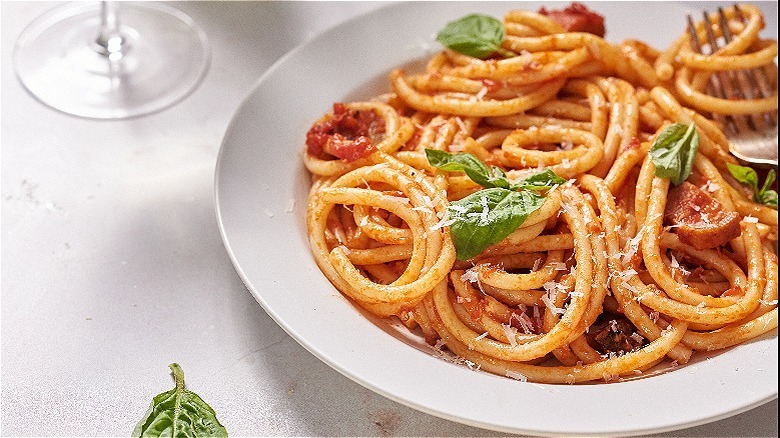
- 1 tablespoon olive oil
- ½ pound guanciale, sliced into 1-inch pieces
- 1 tablespoon chopped Calabrian chiles
- ½ cup white wine
- 1 (28-ounce) can whole peeled San Marzano tomatoes
- 1 teaspoon salt, plus more for the pasta water
- 1 pound bucatini pasta
- 1 teaspoon cracked black pepper
- ¼ cup grated Pecorino Romano
- basil, for topping
- Heat the oil in a skillet over medium heat. Once hot, add the guanciale and cook until golden and crispy on either side, about 5 minutes. Once cooked, add the Calabrian chiles and stir to combine.
- Pour in the wine and bring to a simmer. Reduce, stirring occasionally, until wine is almost completely evaporated.
- Crush the tomatoes by hand and add to the skillet. Season with 1 teaspoon each salt and pepper, then bring to a simmer. Turn the heat to low and stir occasionally to avoid burning.
- While the tomato sauce is cooking, cook the bucatini to package directions for al dente, about 7-9 minutes, salting the pasta water generously while it boils. Reserve 1 cup of pasta water, then drain.
- Once the bucatini is cooked and the tomato sauce is thick, add the pasta to the tomato sauce. Splash in the pasta water, one splash at a time, until sauce marries the pasta. Remove from the heat and toss in the pecorino Romano.
- Serve with basil and extra pecorino, if desired.
| Calories per Serving | 781 |
| Total Fat | 30.2 g |
| Saturated Fat | 9.8 g |
| Trans Fat | 0.1 g |
| Cholesterol | 46.0 mg |
| Total Carbohydrates | 94.9 g |
| Dietary Fiber | 6.2 g |
| Total Sugars | 9.3 g |
| Sodium | 512.2 mg |
| Protein | 26.5 g |
